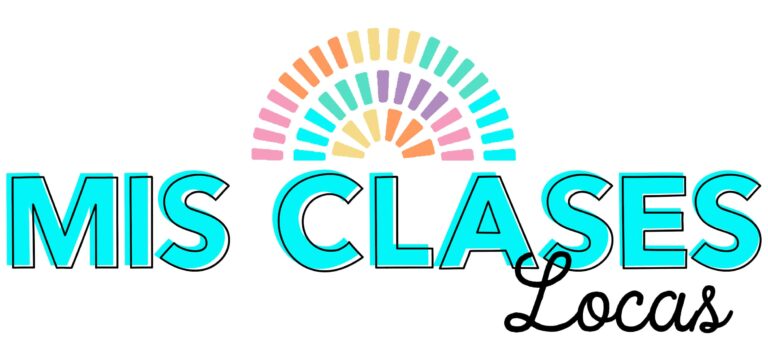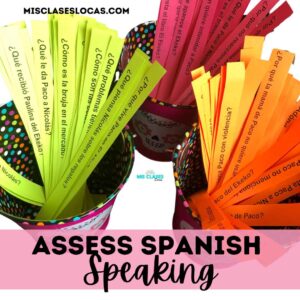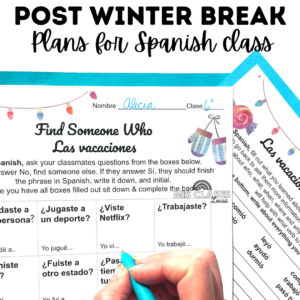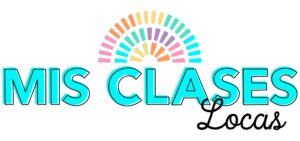Inside: Spanish Question Cards to practice interpersonal speaking in Spanish class. Are you wondering how to get your students to speak Spanish? Learn how to support all learners with differentiated question cards for interpersonal speaking practice and assessment. Why you need them, the types of cards you can use, plus activities to mix up interpersonal speaking in class.

How do you get students to speak Spanish?
A question that has come up in the Mis Clases Locas Group and on Instagram lately, is “how do I get my students to speak Spanish in class?” As language teachers, we know interpersonal communication is very important. Yet, in some classes, it is the skill that is practiced the least. I know in this past year especially, hybrid and virtual teaching made interpersonal speaking very challenging. As many of us move back in the physical classroom, I have a solution to the issue of how to get students to speak in class. The answer is question cards.
What are Question Cards?
To me, question cards are any questions in Spanish on physical cards. These can be a printed sheet of paper that is quickly cut into question strips by students. Or these can be prepared cards that are printed, cut apart, and maybe even laminated to use over and over. They can be small cards that are used with partners, or even large ones that are posted around the room. Personally, I like the term question card as opposed to task card, since they are inherently more communicative. I would rather my students be able to ask and answer questions with each other, as opposed to just picking a multiple-choice response. (Believe me, I know there are a time and place for those specific task cards, and they can be used in many of the ways I have listed below as well).

Why you should Question cards
One of the best things about them is the support and differentiation that you can provide to help reach all learners. As a visual person learning a language, I love being able to SEE a question that is being asked. I have found that this was a huge barrier for my novice language learners as well. The skill of a conversation is both Interpretive Listening AND Interpersonal Speaking. If a student does not have enough support to even know what the question is, there is no way they can begin to answer. Providing the question to be able to be read if needed really supports learners to be more confident to be able to answer and speak.
I know there are people out there who say “Well in the real world they won’t have the question written down.” As facilitators of novice language instruction, we have the important task of supporting all students where they are in their language learning process. For me teaching non-native speakers in their first language classes, means building a bridge to get to that spontaneous conversations.
If I threw my preschool son straight into the deep water of the ocean the first time and shout Swim!, without any support, he would either drown or never want to swim again. This is what we do to early novice language students when we throw them with a partner in week one and say talk to each other in Spanish. Giving them question cards is a floaty to help make the first experience enjoyable, so they want to come back and try again the next day or even the next year.
Types of Question Cards
– Regular Routines like Weekend Chat
– Evergreen Practice like High Frequency Questions as a fast finisher can of questions or no prep plan
– Novel or Unit Review with comprehension questions
– Specific Purpose like Post Summer Break or teaching a verb like Fue. (Below you can see the first day of Spanish 2 students signed under the card if they did any of the following things. Then they later chatted in groups with the same questions on small cards).
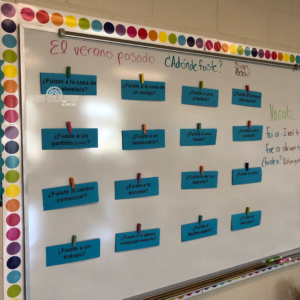
COVID considerations
There are so many ways you can mix up how you use Question Cards. I know every school and situation is different right now in regards to mitigation strategies. For many of the options listed, you can make adaptations to make it work for you. if you did not know, I have been teaching in person all school year with masked students. I spent the first half of the year terrified to try any kind of manipulative.
I have since learned the following adaptions that you can try if you and your school are comfortable with them. Keep everyone masked. Laminate all cards, so they can be wiped down at the end of class. Or, for cards you are going to use over and over like Weekend Chat, have students cut their own set of cards that they keep with them and use over and over. Take students outside or to a large area where they can spread out. Or, I know some school has plexiglass students who can sit behind and speak to each other. Chose one or many accommodations to make it work for YOU.
For virtual learners or hybrid situations, post the question cards document on Google Classroom (or your LMS of choice). Have students practice just looking at the questions and chatting online in break-out rooms or using something like Flip grid. At different times this year, I had quarantined students on zoom on a Chromebook or even face timing in (by choice) for speaking practice with those in person.
Activities for Question Cards – Classic
Classic Partners – Students take turns asking and answering the Spanish Question Cards.
Small Groups – In groups, divide up cards and all students take turns asking and answering questions.
Assessment Practice – My favorite early novice interpersonal assessment over a novel involves question cards. I first copy and paste comprehension questions in a doc. Then I print and cut them apart. These can be laminated to use for multiple years. I print multiple sets to do any of the activities above to prepare for the assessment. *For a Virtual Modification, post this doc on Google Classroom and have students practice just looking at the questions and chatting in person or online in break-out rooms or Flip grid.
Speaking Assessment – Use these exact cards for Interpersonal speaking assessments. You can even color code to differentiate different levels of questions. So students can pick what level they feel comfortable asking. *An easy way to accommodate students with IEPs or 504 plans. See this blog post for many ideas of how I do Interpersonal Speaking Assessments. Below you can see a set of cards for a specific novel that students drew from the can and asked each other for the assessment.

Activities for Question Cards – get students moving!
Write Around the Room – First, post the Spanish Question cards around the room. Next, have students walk around with a clipboard or notebook and answer all questions on paper. This could be a way to support students who want to have prepared answers in advance. After this, you could do any of the other options with the same questions.
Speak Around the Room – Once again, first, post the cards around the room. Students walk around with a partner and ask and answer each posted question out loud.
Speak Around the School or Outside – Post questions around a large common area, the outside of the school, or all around the school if you are able to. Then, students get to walk and chat in pairs. *This a great activity for when the weather gets nice and it is time to review.*
Chalk the Walk (& Talk)- Give each student in your first class a question card and chalk to go write on the sidewalk, outside the basketball court, etc. Then in pairs, students get to walk and talk and answer the questions. *Another great end-of-the-year activity to mix it up and enjoy nice weather.
Quiz, Quiz, Trade – Students each start with one (laminated) card. Then they walk around and find a partner to ask the question to. Each one asks their question, and at the end, they trade cards. With the next partner they ask their new questions, then trade and repeat. *Only if you are OK with sharing cards, if not, skip this one for now.
Getting More Miles Out of Spanish Question Cards
One of the biggest things I have learned is you can use the same cards many times, trying different activities. For one week for a low-key Weekend Chat, students can just chat with a partner. Then on another nice day, spend the first 5-10 minutes of class outside answering a few posted questions. Next, use the same questions another week for a quick formative speaking assessment, where small groups simultaneously chat while the teacher walks around and assesses a few (or all students).
The same goes for chatting about a novel or reviewing for an assessment. I use the same cards to both practice and for the assessments. I do not want these assessments for early novices to be a got ya surprise. They are familiar with and have practiced how they could answer a question. Do they maybe just memorize how to answer “what is your name and where are you from?” Yes and that is OK! We want them to be super comfortable answering those common personalized questions that will come up naturally in conversation.
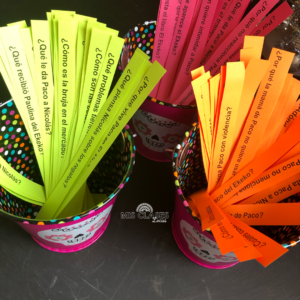
Extension – now Write!
Do you have some time left after doing some of these activities? An easy extension is now WRITE! Do a free write about what you learned from your partner. Or even better a free write comparing yourself and your partner. Write about all of the things you and your classmates did over the weekend or the summer. This is the perfect way to now add in the third person, as well as the plural we and they. Plus, let’s be honest it is a way to use up some extra time that requires zero teacher effort, which is pretty perfect at the end of this school year!
Where Can I Get Ready to go Spanish Question Cards?
You can find all my ready to go question cards here. For the best deal, here is the growing bundle of question cards. All cards below include multiple size variations, are low ink printable, and include differentiated options to use as needed. **Update you can now get the same growing bundle of question cards in my website store.
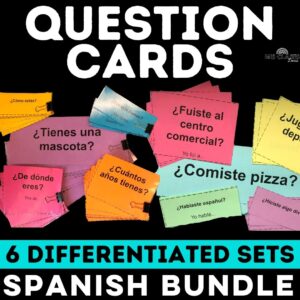
High Frequency Questions – present tense Super 7
Fue – great 1st day of Spanish 2 or early preterite introduction with just one verb
Weekend Chat – for any Monday to practice preterite
Post Summer Break – great first week of school activity for upper level Spanish to use preterite
Novel – discuss any reader or story in Spanish
More Interpersonal Speaking Resources & blog posts
10 awesome speaking activities.
Find Someone Who Interpersonal Speaking Activity Blog Post & all Find Someone Who Activities
Interpersonal Speaking Assessment Idea blog post
Mix up Weekend Chat Blog Post & All resources with the label Weekend Chat
All posts for weekend or post break chat

Or if you want every Mis Clases Locas Speaking Activity all together, get the Speaking Mega Bundle
There you have it. The secret weapon to helping your students have more conversations in Spanish class is Question Cards. Have you tried them? What other variations have you used? Please share in the comments or on social media and tag me!
